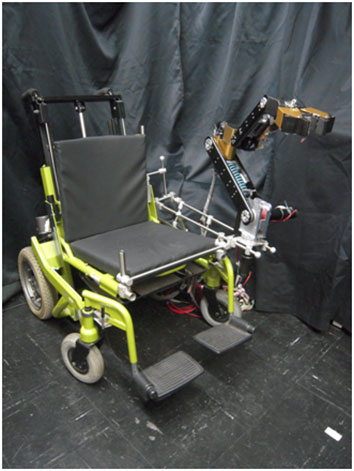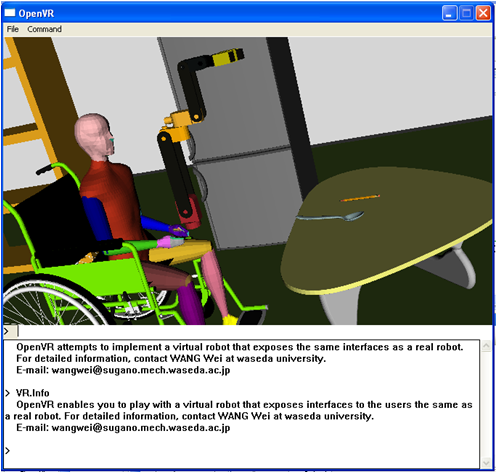Wheel chair robot project
Assistive technology has revealed its great importance in modern society, namely for its use in helping the elderly and disabled to perform functions in daily living activities that might otherwise be difficult or impossible. A wheelchair mounted robotic arm (WMRA) is a kind of assistive robot that combines a powered wheelchair used for mobility assistance with an assistive robotic arm mounted on the wheelchair for manipulation assistance. In this research, we are working on developing a WMRA system that can be used to help individuals with physical disabilities to recover some independence in their daily living activities such as accomplishing the tasks of “picking up an object on the floor,” “bringing a drink to the user's mouth,” “opening doors,” and “scratching an itch.” The main objectives in this research include designing a compact, risk-free, assistive robotic arm that also has good functionality, designing an innovative operating interface that can be used to relieve the physical and cognitive burden of users interacting with it, and developing intelligent manipulation algorithms based on robot perceptions.
 Compact, risk-free assistive robotic arm with high functionality
Compact, risk-free assistive robotic arm with high functionality

Fig. 1:Assistive robotic arm mounted on wheelchair
Assistive robotic arms have been extensively investigated within both academic and industrial settings all over the world. However, very few of them have been able to operate reliably in a real living environment and to achieve market success.
Several specific requirements need to be satisfied in designing an assistive robotic arm in order to deploy it in real living workspaces and environments that are always shared with human beings. For example, the assistive robotic arm must be safe and risk-free in order to be deployed in the vicinity of human beings; the functionality must be sufficient to accomplish different tasks; it must be compact in order to be mounted on a wheelchair and to work in an indoor environment; and the price must also be reasonable for its potential users.
We have adopted a seven-degree-of-freedom configuration in our design in order to provide good functionality and compactness. A mechanism for mechanical gravity compensation has also been introduced in an attempt to achieve a lightweight design. The assistive robotic arm mounted on the wheelchair is depicted in Fig. 1.
 Intelligent robot manipulation based on arm navigation
Intelligent robot manipulation based on arm navigation

Fig.2:The working environment of WMRA within OpenVR
Masterful control of all the joints of an assistive robotic arm is difficult even when performing a simple task and always puts a high physical and cognitive load on the user. We would like to develop an intelligent robot manipulation system based on how the robot behaves autonomously to some extent, which would thus relieve the cognitive burden required for user interaction.
Different computation algorithms such as the high performance IK solver, motion planning algorithms, and task planning algorithms are regarded as essential elements for robot manipulation. A novel arm navigation system has been set up based on the computation algorithms we developed. High-level task description can be fed to the novel arm navigation system and then executed in a transparent way, whereas the arm navigation algorithm itself will take care of all the planning details regarding task specifications and environment conditions without the user having to be concerned about them.
The arm navigation system was implemented with the software platform “OpenVR.” OpenVR is a software tool that can construct a virtual robot and its working environment from CAD source files and point cloud data. The virtual robot can be operated the same as a real robot by providing corresponding controller and sensor interfaces, and it thus contributes to robotics research in concept visualization, robot design, algorithm development, and system integration. We developed and integrated the algorithms for arm navigation in a generalized way within OpenVR. The working environment of our WMRA system within OpenVR is shown in Fig. 2.
 Intuitive operating interface
Intuitive operating interface
An innovative operating interface that not only can be used by individuals with severe physical disabilities, but can also be operated in an intuitive way, is another objective of our research.
 Robot perception based on 3D camera
Robot perception based on 3D camera
Autonomous robots need to have an understanding of the surrounding environment. Research on robot perception that makes use of a 3D camera to investigate information about the environment is another area we plan to pursue.

